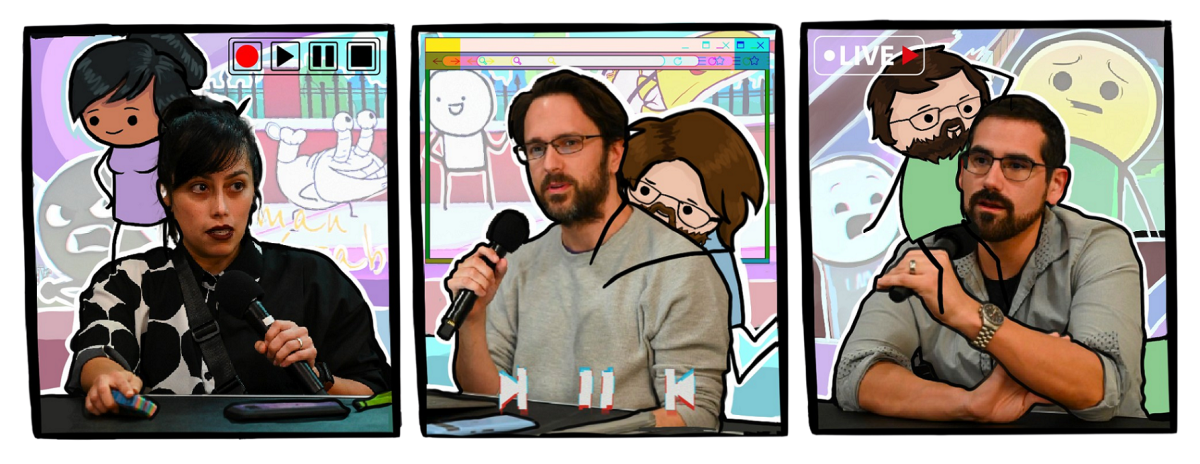The early 2000s were a time of cheesy toy infomercials, colorful comic pages and afterschool cartoons blaring on TV. This nostalgia is revitalized today through the amusing work of David DeGrand, Hector Cantú and Cyanide and Happiness’ Rob DenBleyker, who shared their artistic tips and journeys at Comet Con on March 29.
Comet Con had a variety of attention-grabbing events, but stand-outs included the panel featuring Cyanide and Happiness co-creator and UTD alum DenBleyker. Another panel featured comic creators DeGrand as well as Cantú, who taught graphic novel courses at UTD in fall 2021 and 2023. In an interview with The Mercury, the artists discussed everything from their artistic philosophies to snot.
“Practice makes perfect, and the hardest part is starting,” DenBleyker said. “Just do it, don’t think too much, make mistakes and be constantly willing to improve.”
DeGrand’s endearing and grotesque artwork has brought him to work on projects including “SpongeBob” Comics, “The Simpsons,” “Garfield” and Mad Magazine. DeGrand takes inspiration from the intersection of humor and horror, as seen through his witty comics with gory subject matters like bodily fluids and creepy figures like horror movie characters and disturbing original inventions. Despite his interest in the disturbing, he said that he refuses to cover subjects that are truly damaging, such as poking fun at the handicapped.
“Comedy and horror are very similar in that they both rely on surprise,” DeGrand said. “And so when you’re working on trying to come up with something funny, it needs to kind of come out of the blue with horror. So a good way to get a jolting reaction is like, do something gross and combine the [horror and comedy]. And so they’re very congruent genres. I don’t know why, it’s just how my brain is wired.”
While many comics focus on the fantastical, Cantú’s “Baldo,” which launched in 2000, focuses on nostalgic comic art styles with slice of life themes. Baldo is just an average teen concerned with his family life and his 1964 Chevrolet Impala, and the comic’s long run time can be attributed to this charming relatability. This comic idea came from Cantú’s realization that the comics of his time lacked needed representation of Latin American characters. Both creators find cartoons and comics fascinating because of their wide range of readership.
“The main goal of comics has been to be accessible,” Cantú said. “You want people to easily read the comic, easily look at the images and know what’s going on.” We’re sure they’re very easy to decipher and have fun with … Comics originally were made to complement the newspaper to where anybody could read those comic strips in the newspapers. Whether you’re a third grader or whether you’re an adult, most everybody in the world could look at a comic strip and enjoy it.”
While audiences can appreciate comics with eye-catching art styles and simple dialogue, Cantú and DeGrand recognize the nuance of their pieces and the hidden meanings that can be derived from them. DeGrand’s recent illustration project, “Snot Goblins and Other Tasteless Tales,” is marketed towards children, but subtly discusses relatable scenarios such as alienation through a vampire immigrant. DeGrand finds that tackling tough subjects through fiction can help parents and children understand real world issues.
“[With] the horror genre, you can put a lot of really difficult subjects into kind of a digestible form, you know,” DeGrand said. “Like a lot of kids, I’ve always liked the monster.” I was kind of an outcast, got ostracized a little bit, didn’t quite fit in. Kind of like Frankenstein or King Kong. So I always gravitated towards monsters, which is not really a scary thing. A lot of actual horror comes from the evils that people do.”
As the years progressed, both creators evolved their humor and subject matter while striving to stay true to themselves and remaining relevant to modern audiences. The “Baldo” author finds modern inspiration through his young relatives’ interests, such as the niche internet lore his relatives tell him. No matter the art style or subject, DenBleyker and Cantú said that the internet and social media have simplified the art publishing process.
“There’s so many more outlets for cartooning, that pretty much anybody who draws a cartoon can post it and find an audience,” Cantú said. “Without having to rely on getting a job at a comic book or getting a job as a newspaper cartoonist, you just do it on your own. That’s really changed the ballgame in so many ways.”
Over two decades have passed since DenBleyker first began creating comics in his freshman year at UTD, but the dark humor that made his comics so popular have persisted. Cyanide and Happiness gained popularity for its surreal and graphic humor and is an important staple in meme culture. DenBleyker said that the rise of the internet allows for more creative freedom, which can be necessary for vulgar jokes.
“The only censorship is the censorship you apply to yourself,” DenBleyker said. “Which is reasonable, we should definitely censor ourselves a bit.”
Cyanide and Happiness’ creators continue to work on their comics as a team and Cantú continues to write for “Baldo.” DeGrand is currently working on his first solo project, a comic focused on a happy go-lucky woodland creature who comes to experience real, tough emotions. All the artists find self-expression through their work and encourage students to chase their creative endeavors.
“The students at UT Dallas, they’ve always been very sharp and fun to teach, and very creative,” Cantú said. “They have great ideas. And I’ve always been impressed with the talent that I see in the kids there. A lot of the ideas that I’ve seen in those classes could definitely be developed into graphic novels. So I’m more than happy to encourage the students and get them to create their graphic novels and comics and find an audience for it.”







